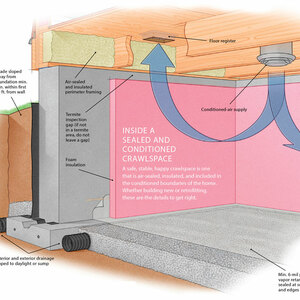wood joist space for heat distribution?
I’ve read in HVAC books where wooden joist spaces are often used as cold air returns to a forced air furnace, but would it be ok for distributing warm air from the furnace to a room? I have an addition, built on piers, which results in an outdoor crawlspace. Before closing up the bottom side, I need to decide how best to heat and insulate. In my situation, the joists run parrallel to the main house, above them are 2×6 deck boards spaced 3″ apart, above that 1/2″OSB, then metal lathe and porcelain tile. It would be easy to use the joist space closest to the house as a warm air plenum, let the heated air fill and travel through the multiple spaces between the deck boards, warming the OSB and floor above as it travels to the far side of the floor, then using the last joist space as a collector where the heat now enters the room through a few floor registers cut in. This would heat the room partially through a warm floor (great!) because much of the heat would go into the floor before it reaches the registers, but will there be any negatives such as the wood drying out excessively and cracking, or tile cracking or detatching?


















Replies
Uhm, did I miss a part where you closed in the bottom of the existing deck joists?
Otherwise, it sounds like the air would just dump out of the bottom of the first joist bay, and then follow the path of least resistance under the deck and out to the outside a bit like and open window.
Let's say that first joist bay is 20' long. That's 240 x 14.5 x 5.5 is 19,140 c.i. or about 11 cubic feet, which, at 250 cfm to pick a number, fills that space in about two-and-a-half seconds. I can't find a good conversion formula to cipher the velocity of the air trying to escape via a 1/4" x 240" gap in the deck boards . . .
Supply ductwork pressurises in use, that's what "forces" the air out of all of the registers at what everspecified CFM the register 'needs.'
Thanks for responding. I neglected to mention all the joist spaces would be filled with 6" of fiberglass, paper side up, except the first and the last which would just have their lower 3" filled, and then the whole affair closed off underneath with plywood. This would allow me to retain storage space underneath by not having to run external ducting, and would yield the benefit of a warm floor. I would run heat duct just to the first joist space, which would distribute it lateraly to the multiple 5 sq.in. passages that exist below my OSB/tile floor. These passages are between the 2x6 decking, which sits atop the joists, and are spaced 3" apart (used to be an old deck, don't worry about the details). I know airflow wouldn't be equal/balanced etc. etc., I'll take whatever flow I get because this is just a spare room that only gets occasional use and has a secondary heat source. I basically just need to know if passing the warm air from the furnace through structural wood (rather than metal ductwork) will have any negative consequences.
Elderbug,
I hate to be critical but firstly, given the subfloor that you describe, I don't think it'll be long before your tiles are popping and/or cracking regardless of whether or not you run heat through the joists. 1/2" OSB over 2x6 spaced at 3" sounds kind of bouncy for tile. Maybe not though. Secondly, if you used the joist bays for distributing heat, how are you going to insulate the floor? One problem with the scenario that you describe is the fact that much of the heat you dump into the joist space will be lost to the outside through your rim joist and whatever you use to close up the underside. I don't believe using joist/stud bays for conditioned air supply is acceptable for a number of reasons primary among them is air quality in the living space (no way to inspect/clean "ducts"). I think your best option would be to run insulated flex duct to a conventional floor register.
Elderbug,
Your proposal is a classic example of the lure of "smart arrows." We all know what smart arrows are -- those are the arrows in HVAC diagrams that show the air which way to travel. The only problem with smart arrows is that no one remembered to educate the air about following instructions. Air follows the path of least resistance, not the smart arrows.
1. Most duct systems are not airtight; the seams leak like crazy.
2. Panned joist bays are notoriously less airtight than ducts; the air has many opportunities to seek out seams and gaps and go wherever it wants.
3. Fiberglass batts are no impediment to air movement.
4. Installing plywood on the underside of your joists is no guarantee that you have created an airtight barrier.
If you follow your plan, most of the air blown into the joist bay will find its way outdoors. Think of your proposed air distribution as a plumbing system. You don't want any leaks; you need to install pipes (ducts) that are leak free. Would you flood your joist bay with water, assuming all the seams would be leak-free? Finally, install a more airtight insulation system than fiberglass batts. Installed in a floor over a crawlspace, batts won't do much to limit thermal transfer.
Well put.
He will also kill his current HVAC distribution system. Even a poorly installed distribution system takes duct sizes and lenght of runs into account. His proposal would be equvilant to cuting one of the main duct runs off at mid run. The resulting loss of static pressure in the rest of the system would mean that none of the remaining supply ducts would get thier designed CFM at the registers. His whole house will suffer from the loss of static pressure and air flow.
To the OP. Do it right, install a balanced distribution system, in the addition, that will meet the required design loads.
Dave
I'm quickly being persuaded to just run external insulated flex duct even though I feel like it's thin layer of insul would allow a lot of heat loss in an outdoor situation like this. What kind of insul would you recommend for the space knowing it will be applied from below to the joist spaces before being enclosed with plywood. Thanks
I think a better approach is to install flat metal ducts against the bottom of the deck, then insulate below those with foamboard. I'd think you could get away with 2" thick ducts, and an inch of foam below them would be far better than using insulated flex, in terms of heat loss.But you'd still want to have the damper valve at the entry point.
If your view never changes you're following the wrong leader
Elderbug,
First choice: closed-cell sprayed polyurethane foam.
2nd: open-cell sprayed polyurethane foam.
3rd: 4 to 6 inches of extruded polystyrene foam, installed in at least two layers with staggered joints, with the last layer installed having joints taped with red contractors' tape, followed by 1x3 strapping screwed through the foam to the joists, with the plywood screwed to the strapping.
I think it's a clever idea, but you'd want to carefully caulk the ends of the bays and the plywood when you applied it. Otherwise, leakage to the outside could really torpedo the concept.
There's also the question of whether there will be enough open space to get enough air through. Even if you calculate that the square inches are sufficient, air doesn't flow as easily through a narrow slot as it does through a wider slot of the same net area.
As to legality and possible damage, we do have a panned joist bay being used for heat distribution in our house (not my choice) and the place hasn't fallen apart yet. But, then, our builder did a number of things that weren't quite kosher.
Someone mentioned that the tile structure is questionable. It would be better to have another 1/2" or so of plywood/OSB/backer board, but the metal lath does provide more stiffness than standard concrete backer board, so you might be OK if the deck structure itself is stiff enough. From the standpoint of the heating scheme there should be no problem.
If you do do this, be sure there's a damper valve where the air enters the joists, so you can cut it all off when you won't be using the space.